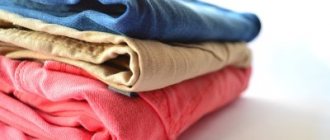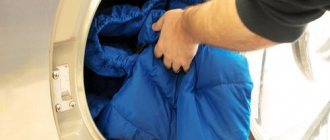How to wash a membrane in a washing machine How to wash things made from a membrane in a machine How to wash by hand How to wash a membrane jacket: drying and aftercare Why do you need impregnation for the membrane
High-quality membrane fabric is durable and comfortable. The synthetic fibers of the material are covered with a polymer film, which simultaneously allows the skin to breathe and keeps the cold out. In such a jacket you will not freeze, but you will not sweat inside, even if the physical activity is serious.
This fabric is used to make ski jackets, trekking suits, children's overalls, down jackets and other specialized clothing for sports and everyday life. High-quality things from the material are produced by such companies as Krokid and others.
Membrane clothing must be washed very carefully. There are several important nuances of washing at home, but you should not think that it is better not to wash such things at all. This is also wrong. In addition, a good wash will help increase the shelf life of the product.
Is the membrane washable?
It is necessary, and absolutely necessary! But before washing, familiarize yourself with the type of membrane and how to care for it. Different means are used for different membranes. Directions are on the tag. You should not engage in “self-medication”, just follow the manufacturer’s advice.
Attention!
Avoid fanatical washing. As with any other clothing, products made from membrane materials lose their protective properties when washed too often, become stiff and less durable. Wash your equipment as soon as it gets dirty.
Features of clothing with a membrane
The membrane material was invented back in 1969 by American inventors and was called Gor-Tex.
Currently, depending on the purpose, membrane clothing comes in several types:
- casual;
- professional;
- for active recreation (Gor-Tex Active).
Its design depends on the purpose of the clothing. Usually this is 2, 3 or 2.5 layers. The membrane itself, which is a thin film with micropores, is attached to the base or located between layers of fabric. The pores are very small, they do not let moisture in from the outside, but with great physical activity they easily remove sweat from the body to the outside.
A wear-resistant coating is used as the top layer, which is additionally treated with a special composition that repels water.
This type of outerwear has the following positive characteristics:
- does not allow moisture to pass through from the outside, but allows the skin to “breathe”;
- protects from wind;
- keeps warm;
- is light and durable.
Along with this, there are also disadvantages:
- High price
- Relatively short service life
- Special requirements for product care
How can you wash the membrane?
For high-quality and effective washing, it is recommended to use special liquid detergents. Stores that sell equipment and workwear made from membrane fabrics always have the appropriate products. They are usually offered at the checkout, and they immediately select the option for your membrane. The best option not to make a mistake is to buy everything you need at once.
- Membrane cleaners are mostly universal, but still read the label carefully before purchasing. Among the recommended manufacturers it is worth mentioning: Nikwax, Grangers, Holmenkol, Collonil.
- Impregnations are more picky; the choice depends on the material, insulation and other details. Some impregnations are initially intended only for backpacks or only for awnings, but not for clothing. If in doubt, ask a consultant for help.
Do not use conditioners, stain removers, antistatic agents or other additional products under any circumstances. Even if your favorite jacket has an unpleasant stain, there is no need to pour bleach on it. This way you will only damage the structure of the membrane; it will no longer be possible to restore it.
Attention!
Do not wash membrane materials with conventional means: loose powders, liquid powders, soap! Even the mark “for delicate washing” should not confuse you. You either won’t achieve any effect at all, or you risk damaging the membrane by clogging micropores and only worsening steam removal.
Proper drying
Drying clothes with a membrane also needs to follow certain rules. Compliance with them will help extend the life of things.
- Do not twist under any circumstances. You can hang the jacket by the shoulders to drain excess moisture, and then gently, without twisting movements, squeeze it out with your palms.
- Wrap the product in a large towel or an unnecessary old sheet. This will also help absorb excess liquid.
- When the fabric is soaked, lay the jacket or trousers on a hard, horizontal surface. It should be covered with a dry cloth, which needs to be changed as it gets wet.
The room in which things are dried should be well ventilated. It is strictly forbidden to dry clothes on hot radiators and heaters, or to iron them. After the items have dried, they are treated with impregnation.
How to wash a membrane in a washing machine
Let's start with the fact that machine washing is generally preferable to hand washing. The drum distributes the load on the product more evenly, which will have a positive effect on its safety. For example, hand washing often affects taped seams, which lose their tightness as a result of intense friction.
Before you start washing, make sure that there are no traces of detergent left in the machine from previous washes. This is especially true for bleaches and stain removers, as well as products containing fluorine or chlorine.
Although the product is used quite economically, it is more expensive than regular powder. To avoid spending too much, you can wash several membrane items at once, for example, a jacket and trousers from one suit.
Before you begin, fasten all available fasteners: zippers, Velcro, buttons, etc.
Detergent GRANGERS Down Wash&Repel 2 in 1 300 ml
More details
GRANGERS Performance Wash 1000 ml
More details
GRANGERS Clothing Care Kit
More details
What mode should I use to wash the membrane?
Set the washing cycle to a gentle cycle at a temperature no higher than 30-40°C with low speed and double rinsing. Suitable modes: synthetics, delicate wash, sports. If the soiling is serious, use the pre-wash mode.
Avoid washing at temperatures higher than those indicated on the product tag. Overheating can damage the membrane. This is also why such things should never be boiled.
Set a small number of spin speeds or abandon it altogether. Be prepared that even after spinning, water will drip from the clothes; this is normal for membrane materials.
Double rinsing is a very important point, try not to miss it. Although membrane products are designed in such a way as not to clog the porous structure, not everything is washed out the first time. In order for the membrane to maintain its breathability, you need to rinse everything thoroughly twice.
Detergents for washing membrane fabrics
Choosing the right and high-quality membrane washing agent is very important. Using the first thing that comes to hand, you can simply ruin an expensive item.
A common question among owners of such things is: can the membrane be washed with regular powder? The answer is categorical - no, it will not work, the film does not tolerate sulfates and phosphates, which are present in large quantities in detergents of this type. In addition, the pores of the membrane will become clogged with powder particles, and it will lose its protective properties.
Recommended products
Removing odor from membrane clothing is somewhat difficult, since this fabric requires special care: it must be washed by hand and with special means.
But even with such care, the service life of this clothing is significantly reduced.
SmellOff against sweat odor
will help you This product is completely natural and does not cause an allergic reaction on the skin. Recommended:
- We clean things from visible dirt. In the case of membrane fabrics, it is better to remove dirt with damp cloths.
- Apply the product by spraying. Particular attention should be paid to areas where sweat is absorbed most often (armpits, back, neck). The product must be poured onto them for deeper absorption.
- After treatment, we leave the product for literally 2 hours (since the membrane dries very quickly) - the clothes become fresh and ready for use.
- The easiest way is to wash clothes with laundry soap. It dissolves well in water and removes dirt from the fabric. The soap is grated, and the resulting fine shavings are dissolved in water without any residue.
- Shampoo, for example, Salton Sport and Domal Sport. This is a certified cleaning product for sportswear with climate membranes. For one wash, the manufacturer recommends using 20-25 ml of liquid. You can buy them in sports stores, along with clothes.
- Special gel, for example, Denkmit Fresh Sensation. When washing in an automatic machine, it is poured into the dry powder compartment. This product does not damage the fabric and takes good care of the membrane. In addition, it gives clothes water-repellent properties.
- Nikwax tech wash liquid soap for membrane. An effective product that removes even heavy dirt and residues of other detergents. It is recommended to use in tandem with impregnation of the same series, strictly following the instructions.
- According to user reviews, gel-con for the membrane will only cope with minor stains and get rid of unpleasant odors.
Advice! If you do wash the membrane with powder or gel containing sulfates, do not despair. Treat it with aerosol impregnation and henceforth use only suitable products.
What should not be used for washing?
In addition to washing powder, the following products are prohibited:
- containing chlorine. They significantly expand the micropores of the membrane, as a result of which it retains moisture from the external environment worse. In addition, chlorine, even in the lowest concentrations, can dissolve water-repellent impregnation;
- any bleaches and stain removers. They act on membrane products in the same way as chlorine.
- You shouldn't use fabric softener either. They give things a pleasant smell, but degrade the quality of the membrane.
Advice! It is not necessary to wash the entire item; you can often wipe away stains with a sponge and laundry soap or dishwashing detergent.
Since membrane products require very careful handling, it is best to wash and tidy them yourself rather than take them to the dry cleaner. After all, the client has no way to track which product the dry cleaning staff uses. It will be very difficult to prove that the item was damaged.
Restoring the impregnation of membrane clothing
The best impregnation option is factory-made. Homemade impregnation, no matter how hard you try, is not as uniform and of high quality. At the same time, there are no restrictions on home processing; feel free to process your equipment as needed.
Important condition:
impregnation treatment occurs only after washing and before the clothes dry. There are two options for the product: spray and rinse.
- Spray impregnation is a simpler option, and in this case the concentration of the product is higher. Just spray the outer layer, trying to do it evenly. Afterwards the equipment is left for final drying.
- Impregnation-rinse aid is a more complex and time-consuming option. You need to dissolve the product in a basin and leave the clothes to soak for a while (exact directions and instructions are on the packaging). Or pour the product into the rinse aid compartment and run the machine again. The option is not bad, the product is distributed more evenly than in the case of a spray, but when diluted with water, its concentration decreases.
What is prohibited?
Habitual actions when washing outerwear can destroy the membrane, so it is necessary to clearly indicate the manipulations that are prohibited:
the use of conventional washing powders clogs the holes with undissolved particles;- washing with chlorine-containing products destroys the structure of the material;
- intensive twisting and wringing lead to stretching of the product and the appearance of micro-tears;
- exposure to temperatures above 40⁰C (hot water and a hot iron) sticks the pores together.
How to dry membrane clothes
To dry washed and treated clothes, do not use dryers, batteries, heaters, and avoid drying near an open fire. Choose a warm room, open the window slightly for better air circulation, hang the product on a hanger and leave it like that until completely dry.
Sometimes it is recommended to dry it in a horizontal position, that is, straighten it and place it on a towel.
If there is a corresponding mark on the tag, then already dry clothes can be placed in the dryer for 15-20 minutes. This will help to better record the results of washing and treatment with a DWR product. If there are no marks, then avoid using dryers altogether.
Preparatory stage
Membrane fabric has a porous structure and is called “breathable”. Sweat from the surface of the human body comes out freely, without creating a greenhouse effect inside.
An indicator of contamination is the heaviness of the jacket: it begins to absorb moisture. So, the time has come to wash your favorite clothes.
Membrane fabric is quite capricious, so manufacturers always attach a tag to the lining indicating the main points of use.
Before washing, you should carefully study the icons:
- temperature regime;
- use of a washing machine;
- possibility of ironing.
The main rule is to take care of the jacket. Individual stains can be easily removed with a soft brush and soapy water . It is worth carefully walking over the dirt, and then drying the product by hanging it on a hanger.
If you need to wash the entire item, do it separately from other outerwear so as not to damage the delicate fabric.
Preliminary preparation:
- inspect the jacket, identify stains and defects;
- remove all items from pockets;
- remove fur parts;
- close the zippers;
- fasten the buttons.
When it is impossible to unfasten fur accessories (for example, pompoms), you should place them in a plastic bag and carefully tie the edges. The fittings are protected with adhesive tape, pasting it on top in several layers.
Treatment with protective agents
To ensure that clothing for fishing and hunting does not become less comfortable over time and does not lose its water-repellent properties, manufacturers recommend applying special impregnation agents to it. Impregnations containing Teflon or silicone create a film that repels water and causes it to roll off the surface of things.
Manufacturers of impregnations produce compositions in the form of sprays and in the form of a liquid that must be added to the water when rinsing.
- Sprays
.
Advantages
: they are easy to apply and dry quickly.
The disadvantage
is uneven spraying in different areas. - Liquid impregnations
.
The advantage
is uniform application.
The disadvantage
is the high consumption of substance. Products are treated with impregnations after cleaning or washing. You can apply the substance to dry items (spray).
Selecting a Cleaning Product
Before washing membrane clothing, it is important to decide on the choice of cleaning agent, to find out what can be used and what cannot be used. It is not recommended to use the following means:
- Dry washing powder. Particles of granules become clogged in the membranes; it is almost impossible to remove them by rinsing, especially if washed by hand. As a result, the fabric may lose its breathability.
- Conditioner-rinse aid. Gives the material a wonderful smell, but reduces its water-repellent properties.
- Chlorine-containing products. They cause the item to lose its hydrophobic properties and get wet in the rain.
- Stain removers. They act on the membrane as chlorine, contributing to the thinning of the fabric and loss of thermal insulation properties.
List of approved detergents:
- liquid washing powder;
- hair shampoo that does not create a lot of foam;
- shower gel;
- soap solution.
For membrane items, it is recommended to use special impregnations during and after washing. They help preserve the hydrophobic characteristics of the material and repel dirt.
Impregnation at home
Manufacturers impregnate membrane fabric with a special composition that protects it from getting wet. Over time, the composition is washed out, and the jacket begins to let moisture through.
The protective layer is restored using special products, which are produced in 2 types:
- Aerosols are sprayed onto the outside of the fabric. The spray makes the material waterproof again. Processing is carried out outdoors.
- Liquid impregnation revives not only the outer layer, but also the entire membrane layer. The composition is poured into a container, the jacket is completely immersed in it for several minutes.
Freshly washed clothes are treated with an impregnating composition. Treatment is allowed to be carried out no more often than once every two cleanings. Otherwise, the pores in the fabric will become clogged and the “breathing” properties will disappear.
Means for impregnation:
| Brand | a brief description of |
| Grangers Performance Repel Spray | Restores the fabric structure to a new state. Apply to a dry surface from a distance of 20 cm. Maximum effectiveness occurs 24 hours after treatment. |
| Grangers Clothing Repel (wash-in) | Impregnation is carried out in a washing machine. The product does not harm the environment. |
| Nikwax TX.Direct Spray-on | Extends the life of clothing. Sprays from a distance of 15 cm. Suitable for items that cannot be washed in a washing machine. |
| Nikwax TX.Direct Wash-in | The liquid restores the water-repellent layer and does not spoil the breathability of the fabric. Use does not harm health and the environment. |
Caring for the membrane and restoring its properties, video review of the products:
Is it possible to iron?
A properly dried item does not require ironing.
The damp fabric, being in a vertical position, smooths out on its own.
Using a hot iron will damage the synthetic layer and all the benefits of the membrane will be lost.
If the jacket is wrinkled for any reason, and you can’t do without ironing, you can use a steam generator . Another option: iron the product with a warm iron through several layers of gauze.
Handwash
Cleaning by hand is the gentlest way to remove dirt . No pre-soaking is required before hand washing. The jacket washes perfectly without additional manipulation.
Step-by-step algorithm:
Prepare your jacket.- Fill the bathroom with warm water no higher than 40⁰C.
- Dilute the detergent.
- Dip the item into the prepared solution.
- Gently rub the contaminated areas by hand or with a brush.
- Rinse thoroughly under running water.
It is strictly forbidden to unscrew the membrane, so the liquid is allowed to drain freely. The jacket is then wrapped in a terry towel to remove excess moisture.
What about drying, ironing and care?
If you do not forget that the membrane does not like high temperatures, then when drying and ironing you will definitely not spoil the item. You will be surprised, but you can dry such things even in a machine or dryer in the most gentle mode. If this option does not suit you, then dry it the old fashioned way.
- Once the water has drained, lay the clothes flat on a drying rack and let the items dry at room temperature.
- Or hang the item on a vertical dryer and wait for it to dry, also at room temperature.
But you shouldn’t use a heater or battery: they generate too much heat, which can ultimately be harmful to the material.
Ironing is not necessary if it is dried properly, but if you decide to iron it, do so only through a layer of fairly thick cotton. For example, through a towel.
Well, don’t forget to restore the hydrophobic coating using special impregnations: this is not necessary, and the membrane will not allow water to pass through anyway, but if you want the water to effectively drain from the jacket in drops and not remain on it, then you will have to impregnate everything with such impregnation get one.
Caring for membrane clothing is not so complicated and by following simple recommendations for washing, drying and ironing such items, you can enjoy the cleanliness of suits and jackets without fear of ruining them.











